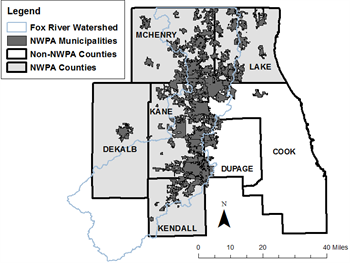
Ron Zack
The Northwest Water Planning Alliance seeks to manage water resources in the region—like the Fox River—to ensure a sustainable, clean water supply for future generations.
This post also appeared on the Metropolitan Planning Council's What Our Water's Worth blog.
Mission statement: The Northwest Water Planning Alliance (NWPA), formed by intergovernmental agreements, seeks to collaboratively plan for and steward our shared river and groundwater resources to ensure a sustainable water supply for the people, economy, environment, and future generations.
The Northwest Water Planning Alliance, a consortium of roughly 80 groundwater and surface water communities in DeKalb, Kane, Kendall, Lake and McHenry counties, took a big step forward on Thursday, Nov. 14, 2013, when the Executive Committee approved the group’s first Strategic Plan since its establishment in 2010. The creation of the plan was made possible by the Chicago Metropolitan Agency for Planning’s Local Technical Assistance program, which provides planning assistance to communities in the region to advance planning projects that align with GO TO 2040 goals. Tim Loftus, water resource planner at Chicago Metropolitan Agency for Planning, facilitated discussions that began in February among NWPA Executive Committee and Technical Assistance Committee members about the future direction of the NWPA and prepared the comprehensive three-year plan. The Metropolitan Planning Council (MPC) also provided input during the process and is tasked with being a lead implementer for a number of outreach initiatives. These discussions, paired with a guiding vision of dependable water supplies in the NWPA area for generations to come, led to a mission statement and very specific objectives and strategies. The plan is intended to help the group expand their presence in the region and focus efforts on three overarching goals that reflect the vision and mission of the NWPA:
- Build the organizational capacity to achieve the mission.
- Provide education and outreach to raise awareness of the value of water as a finite asset.
- Develop sustainable water use policies and practices that are widely adopted and protective of water supplies.
“The importance of the strategic plan is that it confirms the direction in which the NWPA wants to head in the future,” says Peter Wallers, president of Engineering Enterprises, Inc. and Technical Assistance Committee Chairman. That Committee—comprised of local water professionals and utility managers—can work closely with the Executive Committee—comprised of elected officials—to pursue important initiatives in a coordinated way. He further emphasizes the importance of the NWPA’s work, saying that “water is going to be a critical element going forward and we as a region need to do a better job of understanding supply and demand to remain economically strong.” As CMAP’s Water 2050 regional water supply and demand plan describes in great detail, regional water demand is expected to increase in the coming decades, perhaps even dramatically based upon some population forecasts. Regional planning is imperative now to ensure that northeastern Illinois’ aquifers and rivers can sustain the region’s population and economic growth well into the future.
The NWPA Strategic Plan details 11 objectives and evaluation measures along with a number of strategies to achieve each objective. Of course the NWPA will not be able to accomplish these goals without collaborating with partners in the region, so key partners crucial to the success of the plan were identified. They include the U.S. Geological Survey, Illinois State Water Survey, Metropolitan Mayors Caucus, Chicago Metropolitan Agency for Planning and MPC.

The NWPA is comprised of communities in five counties.
Credit—Kaitlyn McClain
Top priorities for 2014 include increased outreach to elected officials through the five county boards and councils of government about the state of the region’s water supply and the importance of water conservation, the roll-out of a new data reporting tool for members to better track regional water supply patterns and the completion of studies in collaboration with the state water survey to enhance our understanding of regional water availability through 2050.
MPC has been providing research and policy assistance to NWPA for the last few years and will continue to do so by building organizational capacity and taking the lead on outreach to both elected officials and the public. I have the pleasure of working with NWPA during my year-long AmeriCorps term of service at MPC. Since I started in July, I have been working on creating new communications materials to pave the way for improved member engagement and widespread adoption of the NWPA regional lawn watering ordinance. Most recently, I worked with the Executive and Technical Assistance Committees to create a monthly e-newsletter to expand NWPA’s audience. The first edition went out in November—subscribe here!

The Fox River is an important water resource for some communities in NWPA.
Credit—Ken Schneider
Achieving the goals and objectives laid out within the plan won’t be easy, but it seems like the group has the determination to bring about some great changes in the region. Each committee has a core group of committed individuals who attend nearly every monthly or bi-monthly meeting. MPC is excited to see what NWPA can achieve in 2014 with the coordination provided by the Strategic Plan and resolve of its leadership bodies.
WOWW Factors
215
Number of people in the region that received the first NWPA newsletter
77
Number of communities within jurisdiction of NWPA
1.3 million
Number ofpeople living within NWPA communities
60.3 million gallons per day
Potential water savings associated with water waste prohibition measures like the NWPA-recommended lawn watering ordinance